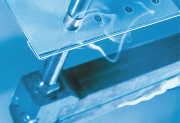 Traditional AC welding users have proved reluctant to embrace the concept of adaptive welding, but this could be about to change. David Halford, welding product manager of Bosch Rexroth, explains why
Traditional AC welding users have proved reluctant to embrace the concept of adaptive welding, but this could be about to change. David Halford, welding product manager of Bosch Rexroth, explains why
Adaptive welding remains a small proportion of the UK’s welding market, but its ability to improve the quality of weld and drive cost out of the manufacturing process could offer an alternative to traditional methods.
AC resistance spot welding is still used in many of the UK’s most sophisticated manufacturing processes, particularly in any metal sheet joining processes, with examples including radiator and wire mesh manufacture. It is also still widely used in automotive manufacturing.
The process, however, is prone to weld disturbance – such as shunting, caused by alternative current paths leading to a loss of energy, bad fitting of sheets and also variations of coating and sheet thickness. Problems can also include deterioration of the condition of welding tips, inclusion of sealer and adhesives between the material, and problems attributable to wear of pneumatic cylinders which creates a variation in weld force affecting weld condition.
Furthermore, the issues surrounding resistance spot welding do not stop once the process is complete. Quality checking is problematic and rests on two methods. First is the ultrasonic inspection method which uses a hand-held probe device that emits ultrasonic waves to ascertain the size of the weld ‘nugget’. However, being manual, individual operators obtain different results from the same weld. In addition, the ultrasonic wave method is a highly skilled task which requires trained operators and a separate weld station.
The second method of checking is to take a proportion of the finished welds and manually open them up, however this will only test selected spot welds and will not illustrate fully the quality of the weld. This also results in an increased scrapped parts.
The setting of weld parameters is crucial in obtaining a ‘good’ weld. Too much energy creates weld ‘splash’, while too little can easily create a weld ‘failure’. Whilst disturbances during the weld can easily create a ‘splash’ the big fear for many users of resistance spot welding is going into the failure zone which, more often than not, will result in the recall of parts.
The adaptive system can assist in the setting of weld parameters by giving far greater visibility in identifying the programs that are exhibiting ‘splash’. It also allows for the setting of cooler weld conditions, with the operator being confident that if disturbances to the weld process do occur, the regulator will adapt accordingly, thus preventing any weld failure. The initial cooler weld parameters use a lower heat with less energy consumed, meaning a production cost saving.
There is therefore a slow but steady conversion to resistance spot welding adaptive systems.
Benefits
An adaptive welding system has the potential to offer far more control to a production process as it monitors the condition of the weld during the process every millisecond, compensating for process disturbances by adjusting current and, if applicable, weld time. These adjustments optimise the weld process to ensure the correct energy is applied to all of the welds, which in turn will mean that the correct size weld ‘nugget’ is achieved.
Rexroth’s adaptive welding system has a U (voltage) I (current) regulator which takes inputs from either the primary or secondary current, as well as a voltage tap on the electrodes. Dynamic resistance during the weld is calculated from the sensed current and voltage.
The UI regulator compares the values for the actual and reference resistance every millisecond – if there are differences, the regulator adjusts the weld current accordingly. At the end of the programmed weld time the regulator compares the weld energy with the energy for the reference weld and, if necessary, the time may be increased. The regulator ensures that the same amount of energy that was required to create the reference weld is input into all subsequent welds.
Another key benefit is that a warning or error message can be communicated when a process limit has been exceeded. The process can be halted until a technician or engineer intervenes to check the cause of the disturbance. The system also allows for the production of documentation from process data allowing for greater traceability of welded parts. The system displays all the process-critical parameters online in a diagram, enabling accurate visualisation of the process.
Additional benefits also include a reduction in post-weld checks and a reduction in the number of test parts and time taken checking the weld condition. In turn, this reduces production time and cuts the number of personnel required at the manufacturing site.
Early adopters have embraced adaptive welding as a method of ensuring good quality and driving cost out of the welding process, but it remains a small proportion of the total market. However, it is becoming increasingly clear that relentless production cost pressures are moving the market in this direction.